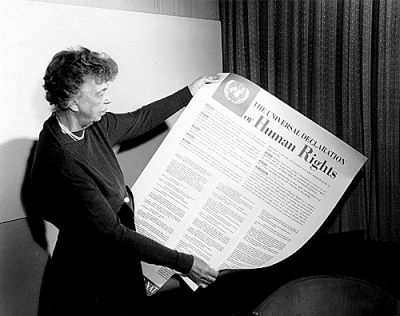|
Click above, for other articles in
the September 2004 issue.

Eleanor Roosevelt
The Universal Declaration of Human
Rights
At the conclusion of World War II (1945), after the Yalta conference, the
Allies issued a charter that came to be known as the Nuremberg Principles. The document set forth the
following; that wars
of aggression were a crime against international society; that any nation that persecutes,
oppresses, does violence to individuals or minorities, on political,
racial, or religious grounds in connection with such a war, and by such means,
seeks to exterminate, enslave or deport civilians, commits a crime
against
humanity.
The Nuremberg Principles applied to belligerent action
commencing with war, it did not apply to similar atrocities committed
during peacetime within national boundaries; it did not apply to governments
that subjugated its own people to such
violence.
As delegates from nations across the globe
convened in San Francisco, in 1945, to begin discussions for the drafting of the
charter
of the future United Nations, they brought with them an unspoken hope,
of adopting similar principles-- specifically those that President Roosevelt had
often cited in his radio talks during the war, directed at the American
people—the “four freedoms”. This, however, was not what these
delegates found, the major powers had no interest in supporting such
principles for fear that it would create a mandate within their national
boundaries. There was no desire for the great powers to be bound by
examination by the international community. To the shock of the United States and
the USSR, Roosevelt’s “four
freedoms” had established a wider audience, that would not so soon forget,
the voiced hope for a different and more just world. So in this vein, the 'third world
diplomats', representing the Philippines, Mexico, and other Latin American nations, made it
known that a Human Rights commission needed to be established.
The driving force that would lead to the
declaration of human rights, was born.
The Universal Declaration of Human Rights was
adopted in 1948, it continues to be cited as the noblest of the United
Nations’ agreements. It has been
used as the source for ninety constitutions, various national constitutions, and
is often referenced by journalists, governments, human rights activists and
citizens worldwide, who fight against atrocities on behalf of mankind. The document was the work of the 1946 Human
Rights Commission, made up of diplomats from Australia, Belgium,
Byelorussia, Chile, China, Egypt, France, India, Iran, Lebanon, Panama,
Philippines, Ukraine, USSR, United Kingdom, United States, Uruguay, and
Yugoslavia. However it was mainly
conceptualized by five individuals;
Peng-chun
Chang, a Chinese philosopher,
playwright and diplomat;
Dr. Charles
Malik, a Lebanese existentialist
philosopher and diplomat, who was a former student of Alfred North Whitehead and
Martin Heidegger;
Rene
Cassin, a French legal scholar, who
had established the legal framework for the exiled Free French government during
WWII;
John
Humphrey, a Canadian legal
scholar; and
Eleanor
Roosevelt, wife of deceased President
Franklin Delano
Roosevelt.
The drafting of the declaration’s language was a
long drawn out tedious affair. Its
language had to deal with issues of conflicting political views, and immense
cultural differences. Chang and
Malik are credited as the intellectual architects, Cassin and Humphrey, gave the document its legal
structure, and Eleanor Roosevelt was its spiritual guiding force. It was Roosevelt who exerted a firm
hand, held the delegates unified in purpose, by seeing the drafting of the
declaration to its conclusion and subsequent adoption.
Eleanor Roosevelt expressed the hope that the
Declaration would surpass the importance of prior historical documents such
as; the Magna
Carta, the French Declaration of the Rights of Man and of the Citizen,
drafted during the French Revolution of 1789, and the U.S. Bill of Rights. In fact, the Universal
Declaration goes beyond these earlier documents and includes “freedom from
want”; that such freedoms must not be conditioned by espousing particular
political beliefs, membership in a particular nation, social origin, race or gender. It declares freedom of opinion as
inviolable, and mandates free elementary education. It also heralds social and economic
rights, thus going beyond the U.S. constitution’s established rights.
The principles and language of the Declaration
became a focus of discussion and criticism in a conservative United States. Frank Holman, President of the American
Bar Association declared the document as a manifesto “which promoted state
socialism” and other American voices along with his, led American debate on the
document’s viability as not worthy of adoption. The late 1940’s were imbued with a climate of the early
cold war, just prior to the McCarthy witch hunts of the 1950's. Had it not been for Eleanor Roosevelt’s
dynamism and vision, the U.S. would not have aligned with the rest of the world
in adopting the document. In fact
John Foster Dulles, then at the State Department did all he could to derail its
adoption.
At the election of Dwight Eisenhower, Eleanor
Roosevelt tendered her resignation
from the UN Human Rights Commission, and American diplomacy suffered as a
result. Further international
agreements, such as the Genocide Convention
would not be ratified by the United States until 1988 during Ronald
Reagan’s administration. The Genocide
Convention had been ratified by the majority of nations in
1948.
V.S.
Posted September 23, 2004
URL:
www.thecitizenfsr.org
SM
2000-2011
You are here: HOME page-OLDER ISSUES-SEPTEMBER 2004 -Looking Back
Previous : Focus on Newark NJ Next : Recommended Reading
|